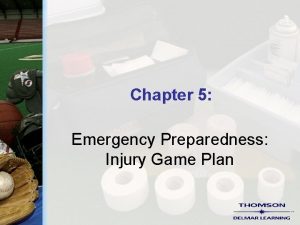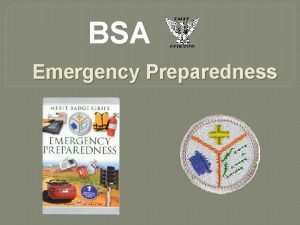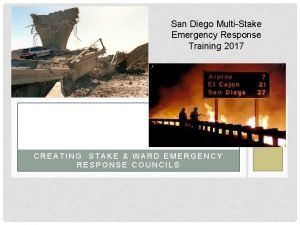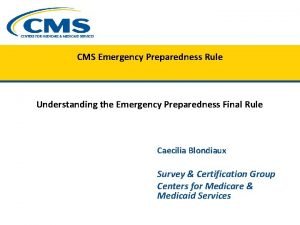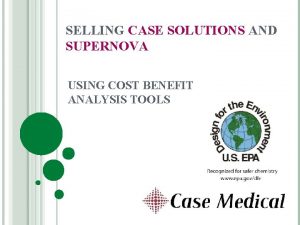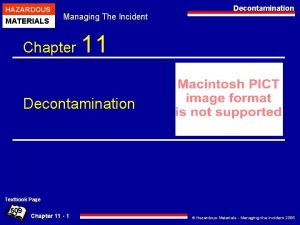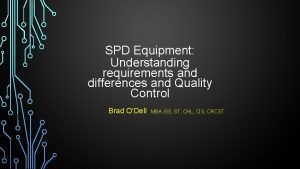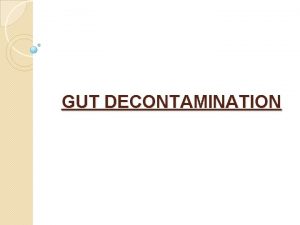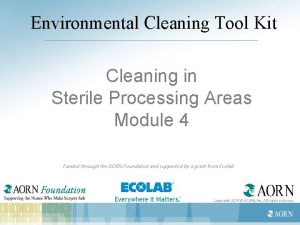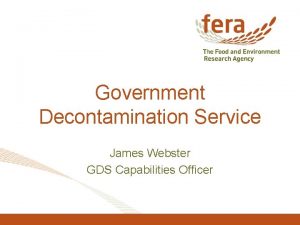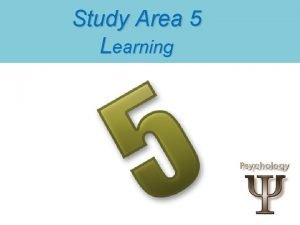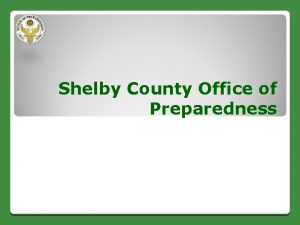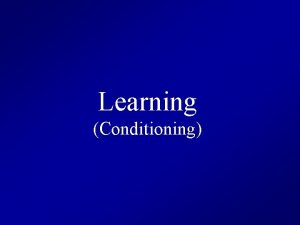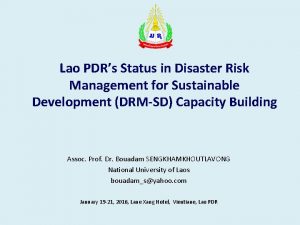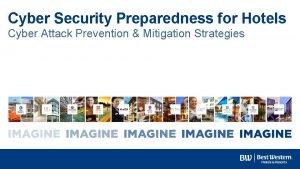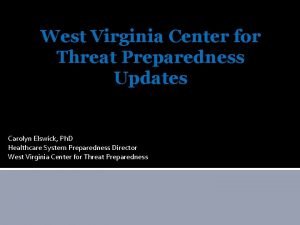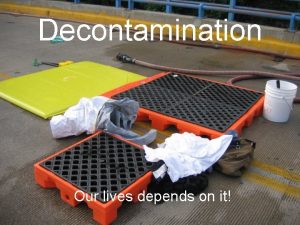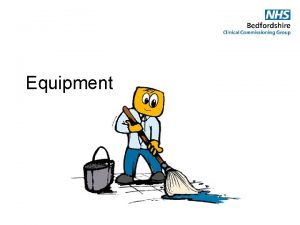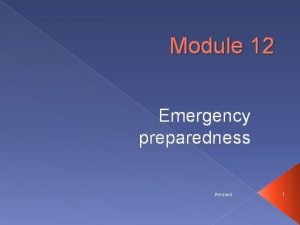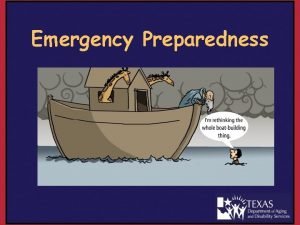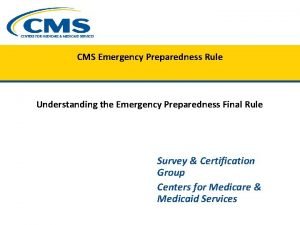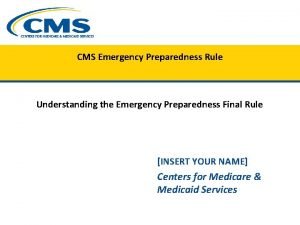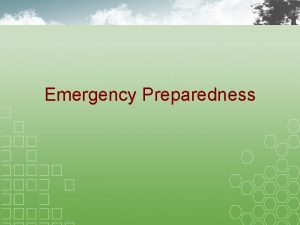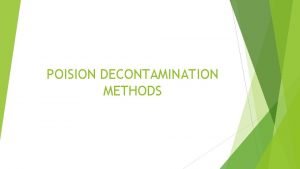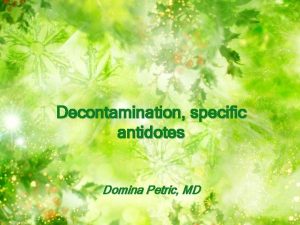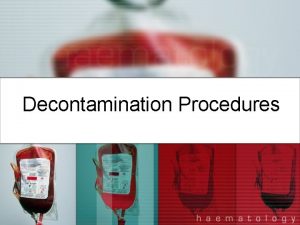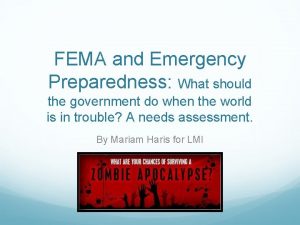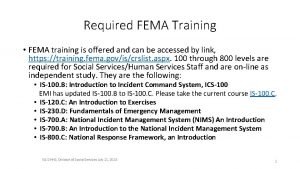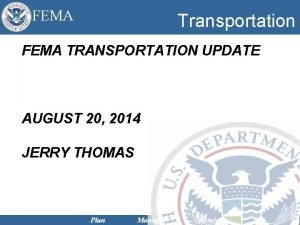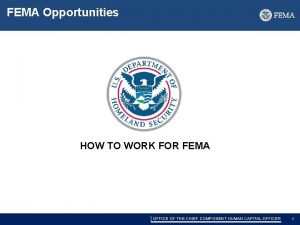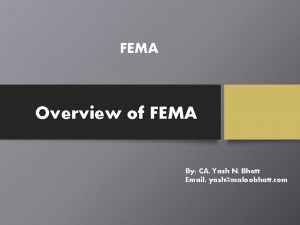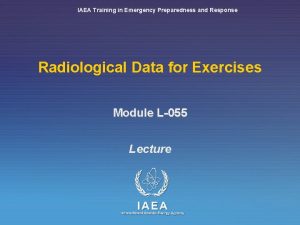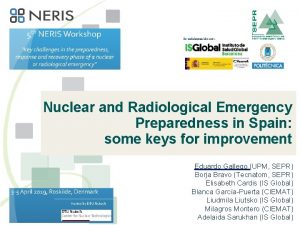Animal Monitoring and Decontamination FEMA Radiological Emergency Preparedness






























- Slides: 30

Animal Monitoring and Decontamination FEMA Radiological Emergency Preparedness Program USDA Animal and Plant Health Inspection Service Michael Howe FEMA REP Program Gordon Cleveland USDA APHIS, Veterinary Services May 5, 2016 1

Why Is FEMA Concerned with Radiologically Contaminated Animals? 2

Some Recent History The Americans with Disabilities Act of 1990. Pets Evacuation and Transportation Act of 2006. American Veterinary Medical Association Letter to the FEMA Administrator and the Administrator’s Response, 2014. FEMA REP Program Letter to USDA APHIS, 2014. Federal Radiological Preparedness Coordinating Committee (FRPCC) Subcommittee on Animal Monitoring and Decontamination. 3

Radiological Emergency Plans Must Include Animal Monitoring and Decontamination Service animals and pets must be monitored and decontaminated if necessary: § Americans with Disabilities Act required provisions for service animals. § The Pets Evacuation and Transportation Standards Act of 2006 requires FEMA to assure that plans take household pets and service animals into account. § People will show up at monitoring, registration, and/or reception centers with pets and service animals, regardless of instructions and messaging. 4

International Fund for Animal Welfare Fukushima Mission Livestock and pet evacuation from the Fukushima Dai-ichi Exclusion Zone: § Cattle permitted evacuation and/or slaughter if below 100, 000 CPM. § Pets required 10 times further reduction: 10, 000 CPM. § Hitachi Aloka TGS: 146 beta/gamma. 5

PETS ACT and Radiological Preparedness The Problem: 6 6

PETS ACT and Radiological Preparedness What Is a Pet? 7 7

PETS ACT and Radiological Preparedness PETS: § Domesticated animals such as dogs, cats, birds, rabbits, rodents, or turtles kept for companionship/pleasure (not commercial purposes) that can travel in commercial carriers and be housed in temporary facilities. § Does not include reptiles (except turtles), amphibians, fish, insects/arachnids, farm animals, horses, and animals kept for racing or avian athletes. 8 8

PETS ACT and Radiological Preparedness AVMA has requested pet, service, and working animals be included in the FEMA REP Program Manual. AVMA, DHS, FEMA, USDA, and HHS NDMS sponsor R&D programs for evacuation, decontamination, and sheltering of these animals. Public Health Emergency Medical Countermeasure Enterprise (PHEMCE) Implementation Plan 2012 has been approached for sponsorship. 9 9

Radiological Emergency Plans Must Include Animal Monitoring and Decontamination. In his response to the AVMA, the FEMA Administrator committed the REP Program to include guidance for household pets in upcoming revisions to the REP Program Manual and NUREG-0654/FEMA-REP-1. 10

Radiological Emergency Plans Must Include Animal Monitoring and Decontamination. Criteria for Preparation and Evaluation of Radiological Emergency Response Plans and Preparedness in Support of Nuclear Power Plants (NUREG-0654/FEMA-REP-1) and the REP Program Manual now include additional language reinforcing the requirement to include consideration of service animals and household pets in radiological emergency plans. 11

Monitoring FEMA is concerned with public protection. Monitoring standards for service animals and pets are assumed to be the same as that for members of the public for public protection. Animals that cannot be monitored should be isolated to prevent contact with members of the public. Animals found to be contaminated must be decontaminated or isolated to prevent contact with members of the public. 12

Through the FRPCC, the FEMA REP Program Has Turned to USDA APHIS FRPCC Strategic Action Plan for Calendar Year (CY) 2015: § Initiative #6: Increasing Capabilities in Animal Monitoring and Decontamination. § Subcommittee Chaired by USDA APHIS VS Office of Science and Interagency Coordination. 13

FRPCC Subcommittee for Monitoring and Decontamination of Animals Goals and Objectives: § Establish scientifically validated methodologies for the internal and external radiological decontamination of animals. § Develop appropriate training for the response community in evacuation and decontamination of animals. § Develop radioisotope surrogates for external decontamination training. 14

Pet Evacuation: How Many Pets ? ? National average: For every 1000 households. 2600 people. 1559 household pets: 1378 (AVMA) 1671 (APPA). All figures vary with community demographics. Quick method: Number of people x 0. 6. 15

Pet Evacuation Follow instructions from Joint Information Center (Via EAS, police, or Extension Agent, from IC). Follow prescribed routes. Bring photographs of you and your pets. 16

Pet Evacuation Bring sufficient food and water for at least 1 week. Bring all medications, records, contact info for veterinarian, and petfriendly shelters. Bring cages, muzzles, leashes, and other restraints as necessary. 17

Pet Decontamination Mass EVAC: IND/RDD Estimate 1, 000 people per hour through Reception Centers. Estimate 650 pets per hour for monitoring and decontamination. 18

Pet Decontamination What’s wrong with this picture? http: //www. ncbi. nlm. nih. gov/pm c/articles/PMC 372253/ Not enough veterinary resources for anesthesia and subsequent antidote. Cats kept in carriers. Dried en masse with industrial heaters. 19

Monitoring Decontamination: Dependent on characteristics of the deposition. How clean is clean enough? Advisory Team PAR would likely be a “One Health” statement: 10 CFR 20. 1301: “Dose in any unrestricted area from external sources does not exceed 0. 02 m. Sv (0. 002 rem) in any one hour. ” With ALARA Recommendations. 20

Therapeutic Countermeasures Food and Drug Administration (FDA) regulates veterinary medicines through their Center for Veterinary medicines (CVM). FDA CVM will not authorize the use of radiotherapeutic interventions (such as Prussian Blue) for animals. Public perceives that livestock might be treated and returned to service. 21 21

Therapeutic Countermeasures CVM allows veterinarians to prescribe human pharmaceuticals for animals: limited supply, expensive, and dose rates unknown. CVM can “wave a wand” and authorize the use of radioprotective products for animals, but dose rates are unknown. 22 22

Therapeutic Countermeasures CBRN Nonclinical Studies/BARDA Animal Models Program are all irradiation studies except one: pediatric Radiogardase. Minipigs, ingestion, but still farm animals: multitude of IAEA/FAO post-Chernobyl studies. One rat ingestion study. 23 23

FRPCC Subcommittee on Monitoring and Decontamination of Animals Current Proposals: External Decontamination: Texas A & M Proposal for product (Environmental 1) efficacy proof of concept: § Hydro and lipo-philicity. § EPA Environmental Friendly list. § Removes Bakkan crude oil, but “may cause a rash” on skin in concentration. § Test with a array of anticipated nuclides with differing physiochemical characteristics. § Comparative study with Dawn dish soap. 24 24

FRPCC Subcommittee on Monitoring and Decontamination of Animals Current Proposals: External Decontamination: University of Florida for decontamination methodologies efficacy proof of concept: § Tc 99 m, 100% gamma emitter with very short half-life. § Test an array of methodologies: dry tape roller, wet/dry vacuum, deluge water, spot removal with “Dawn” and intense scrubbing, and clippers. § Previous work with cadavers. § All permits in place for use of live animals. 25 25

FRPCC Subcommittee on Monitoring and Decontamination of Animals Current Proposals: Internal Decontamination: Oregon State University: Develop radiological screening and internal decontamination procedure for pets, service, and working animals: § Decontamination and/or decorporation strategies. § Uptake, retention, biokinetics, and bioelimination of selected radionuclides. § Detection methods, detection limits, and associated body burdens. § Dose rates to humans from animals with internal contamination and their effluent. 26 26

FRPCC Subcommittee on Monitoring and Decontamination of Animals Current Proposals: Internal Decontamination: Dose rates to humans from animals with internal contamination and their effluent: § Unlikely to be sufficiently internally contaminated to be a persistent threat to owners, clients, or handlers. § Owners/clients/handlers may refuse repatriation until animal is “clean. ” § NRSC/APHIS Animal Care estimate sheltering cost of $125/animal/day. § 10 CFR 20. 1301 Scientifically validated acceptable level, national standard, deterrent to litigation. 27 27

Next Steps Engage the HHS ASPR Public Health Emergency Medical Countermeasures Enterprise (PHEMCE) 2012 Initiative. Engage DHS Science and Technology. 28 28

Next Steps Engage the HHS ASPR Public Health Emergency Medical Countermeasures Enterprise (PHEMCE) 2012 Initiative. Engage DHS Science and Technology. 29 29

Questions? Contact Information: Michael F. Howe Health Physicist Radiological Emergency Preparedness Program Technological Hazards Division FEMA/DHS michael. howe@fema. dhs. gov 202 -306 -5750 Gordon S. Cleveland Senior Staff Officer/Radiological Program Analyst Advisory Team for Environment Food and Health USDA APHIS VS OSIC gordon. s. cleveland@aphis. usda. gov 301 -851 -3597 30
 National radiological emergency preparedness conference
National radiological emergency preparedness conference Chapter 36 emergency preparedness and protective practices
Chapter 36 emergency preparedness and protective practices Chapter 36 emergency preparedness and protective practices
Chapter 36 emergency preparedness and protective practices Chapter 5 emergency preparedness injury game plan
Chapter 5 emergency preparedness injury game plan Bsa emergency preparedness
Bsa emergency preparedness Stake emergency preparedness plan
Stake emergency preparedness plan Cms emergency preparedness final rule
Cms emergency preparedness final rule Center for devices and radiological health
Center for devices and radiological health Radiological dispersal device
Radiological dispersal device Tennessee division of radiological health
Tennessee division of radiological health Steris decontamination sinks
Steris decontamination sinks 4 types of decontamination hazmat
4 types of decontamination hazmat Steris adjustable height sink
Steris adjustable height sink Gut decontamination
Gut decontamination Sterile processing decontamination ppe
Sterile processing decontamination ppe Government decontamination service
Government decontamination service Sphair decontamination
Sphair decontamination What is disaster
What is disaster Dog bite pictures
Dog bite pictures Shelby county office of preparedness
Shelby county office of preparedness Insight learning theory
Insight learning theory Conditioning learning
Conditioning learning Conclusion on disaster management
Conclusion on disaster management Preparedness mitigation response recovery
Preparedness mitigation response recovery Biological preparedness
Biological preparedness Promoting family earthquake preparedness
Promoting family earthquake preparedness Hotel cyber security
Hotel cyber security 1achors
1achors West virginia center for threat preparedness
West virginia center for threat preparedness Who pip framework
Who pip framework Implementing nfpa 1600 national preparedness standard
Implementing nfpa 1600 national preparedness standard



